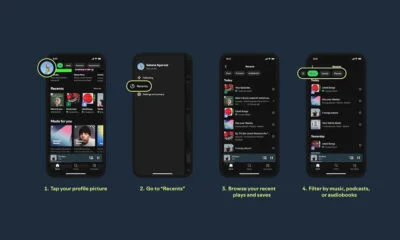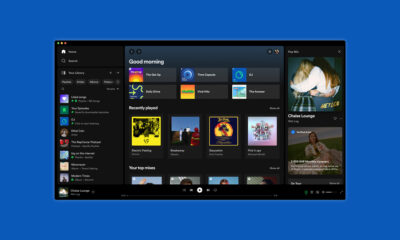News
Spotify Is Now Available In 80+ Additional Countries

Spotify, the world’s largest audio streaming platform, has recently become available in more than 80 additional countries across Asia, Africa, and the Caribbean.
Thanks to the expansion, Spotify will now be able to potentially attract as much as 1 billion new listeners, who can enjoy its growing catalog of songs and podcasts in 36 extra languages. “These moves represent Spotify’s broadest market expansion to date,” stated the Swedish company.
Currently, Spotify users from all newly supported countries have full access to the streaming platform’s global music catalog, but its podcast catalog is not yet available in certain locations. To make its services more attractive to local audiences, Spotify is determined to work with local creators and partners to expands its music offering by including regional artists.
Spotify has been with us since 2008. The service now enjoys 345 million monthly active users (155 million of which are premium paying subscribers). “For the first time ever, we have the technology to connect the world through audio,” said Chief Executive Officer Daniel Ek at an investor event known as #StreamOn.
During the event, Ek talked about Spotify’s desire to become a full-fledged audio streaming platform offering all kinds of audio content. The service is already home to around 2 million podcasts, and its audiobook library is growing at a similarly impressive pace. Spotify has also announced dozens of new original series, such as sports shows and celebrity talk shows.
Also Read: Apple Likely To Release 8K VR Headset In 2022
In addition to the market expansion, the company has also announced Spotify HiFi which will be available later this year. Spotify HiFi changes the way people listen to music as it delivers all tracks in CD-quality, lossless format, giving users much more depth and clarity.
Newly supported countries:
Angola, Antigua and Barbuda, Armenia, Azerbaijan, Bahamas, Bangladesh, Barbados, Belize, Benin, Bhutan, Botswana, Brunei Darussalam, Burkina Faso, Burundi, Cabo Verde, Cambodia, Cameroon, Chad, Comoros, Côte d’Ivoire, Curaçao, Djibouti, Dominica, Equatorial Guinea, Eswatini, Fiji, Gabon, Gambia, Georgia, Ghana, Grenada, Guinea, Guinea-Bissau, Guyana, Haiti, Jamaica, Kenya, Kiribati, Kyrgyzstan, Lao People’s Democratic Republic, Lesotho, Liberia, Macau, Madagascar, Malawi, Maldives, Mali, Marshall Islands, Mauritania, Mauritius, Micronesia, Mongolia, Mozambique, Namibia, Nauru, Nepal, Niger, Nigeria, Pakistan, Palau, Papua New Guinea, Rwanda, Samoa, San Marino, Sao Tome and Principe, Senegal, Seychelles, Sierra Leone, Solomon Islands, Sri Lanka, St. Kitts and Nevis, St. Lucia, St. Vincent and the Grenadines, Suriname, Tanzania, Timor-Leste, Togo, Tonga, Trinidad and Tobago, Tuvalu, Uganda, Uzbekistan, Vanuatu, Zambia, and Zimbabwe.
News
Google Releases Veo 2 AI Video Tool To MENA Users
The state-of-the-art video generation model is now available in Gemini, offering realistic AI-generated videos with better physics, motion, and detail.

Starting today, users of Gemini Advanced in the MENA region — and globally — can tap into Veo 2, Google’s next-generation video model.
Originally unveiled in 2024, Veo 2 has now been fully integrated into Gemini, supporting multiple languages including Arabic and English. The rollout now brings Google’s most advanced video AI directly into the hands of everyday users.
Veo 2 builds on the foundations of its predecessor with a more sophisticated understanding of the physical world. It’s designed to produce high-fidelity video content with cinematic detail, realistic motion, and greater visual consistency across a wide range of subjects and styles. Whether recreating natural landscapes, human interactions, or stylized environments, the model is capable of interpreting and translating written prompts into eight-second 720p videos that feel almost handcrafted.
Users can generate content directly through the Gemini platform — either via the web or mobile apps. The experience is pretty straightforward: users enter a text-based prompt, and Veo 2 returns a video in 16:9 landscape format, delivered as an MP4 file. These aren’t just generic clips — they can reflect creative, abstract, or highly specific scenarios, making the tool especially useful for content creators, marketers, or anyone experimenting with visual storytelling.
Also Read: Getting Started With Google Gemini: A Beginner’s Guide
To ensure transparency, each video is embedded with SynthID — a digital watermark developed by Google’s DeepMind. The watermark is invisible to the human eye but persists across editing, compression, and sharing. It identifies the video as AI-generated, addressing concerns around misinformation and media authenticity.
While Veo 2 is still in its early phases of public rollout, the technology is part of a broader push by Google to democratize advanced AI tools. With text-to-image, code generation, and now video creation integrated into Gemini, Google is positioning the platform as a full-spectrum creative assistant.
Access to Veo 2 starts today and will continue expanding in the coming weeks. Interested users can try it out at gemini.google.com or through the Gemini app on Android and iOS.

























